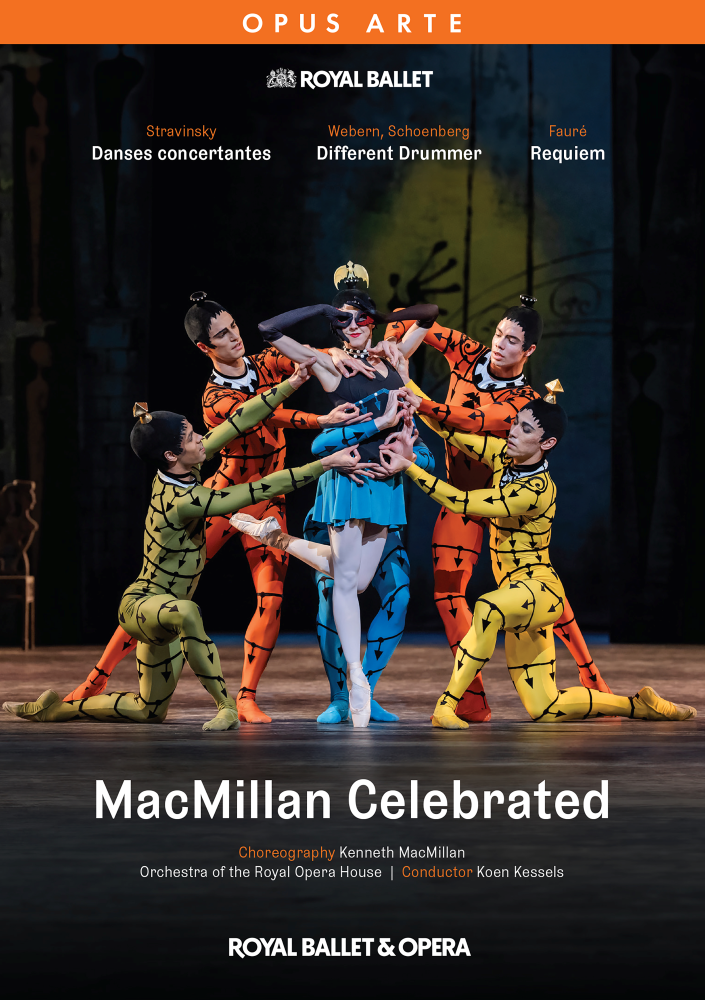MacMillan Celebrated
Three one-act ballets choreographed by Kenneth MacMillan
Danses concertantes (1955)
Music by Igor Stravinsky (1882-1971)
Different Drummer (1984)
Music by Anton Webern (1883-1945) and Arnold Schoenberg (1874-1951)
Requiem (1976)
Music by Gabriel Fauré (1845-1924)
Isabela Diaz (soprano), Josef Jeongmeen Ahn (baritone)
Artists of the Royal Opera Chorus and Ballet
Orchestra of the Royal Opera House/Koen Kessels
rec. 2024, Royal Opera House, Covent Garden, London, UK
Opus Arte OABD7325D Blu-ray [126]
In February this year I visited Prague to see a production of Kenneth MacMillan’s ballet Manon. Said to be the first one ever mounted in the Czech Republic, it turned out to be so enjoyable that I subsequently booked a seat for a second performance. And I was not the only one who appreciated the show. The Prague audience gave it a rapturous reception.
Even had the performance not been first class, however, I still think that it would have gone down well. After all, audiences generally love full-length and accessible narrative ballets. They are the productions that can usually be relied upon to put bottoms on seats, especially in the UK and Europe. And yet nowadays financial constraints are making many ballet companies wary of mounting such shows, given that they usually feature large casts and expensive costumes and sets. Obvious money-spinners such as Swan lake or Giselle may still be economically viable, but, otherwise, big new productions are increasingly seen as risky ventures.
The choreographer Kenneth MacMillan was working several decades ago, however, and that was in a very different age. Thus, the full-length narrative ballet is the form most responsible for keeping his name in the public eye. Romeo and Juliet (1965), Manon (1974) and Mayerling (1978) still regularly fill theatres, not just at Covent Garden and Prague but all around the world. Nevertheless, as both Director of the Royal Ballet (1970-1977) and as a choreographer, MacMillan also produced plenty of other shorter, somewhat less elaborate ballets, both to create artistically varied seasons and to offer opportunities to as many of his dancers as possible.
Interestingly enough, professional critics sometimes suggest that it is those smaller-scale creations that showcase MacMillan’s genius particularly effectively. The late and much missed Clement Crisp, for instance, wrote admiringly of “those short ballets in which his questioning talent was so bravely shown” (quoted in Clement Crisp reviews: six decades of dance ed. Gerald Dowler [London, 2021], p. 89). Three such works – Concerto (1966), the crowd-pleasing Elite syncopations (1974) and The Judas tree (1992) – were featured on an Opus Arte disc released 15 years ago (Blu-ray OA BD7074 D). This belated follow-up now presents three more of MacMillan’s shorter ballets, choreographed over a span of nearly 30 years and thus representative of different phases of his career. Two of them, Danses concertantes (1955) and Requiem (1976), are atmospheric yet essentially plotless. The third, Different drummer (1984), delivers a concentrated, stripped-to-the-bone danced version of Georg Büchner’s fragmentary and unfinished play Woyzeck (1836), which opera fans will know as the original source of Alban Berg’s Wozzeck (1925).
MacMillan seems to have had a particular fondness for choreographing Stravinsky’s music, utilising it over the years not only for Danses concertantes but for Agon (1958), Le baiser de la fée (1960, revised 1986), The rite of spring (1962), Olympiade (1968) and Orpheus (1982). Referring to Danses concertantes, the choreographer himself pointed to the importance of “the spikiness of the music and its sort of off-beat, jazzy quality” (Jann Parry Different drummer: The life of Kenneth MacMillan [London, 2009], p. 148). With the dancers kitted out in Nicholas Georgiadis’s bright, strikingly-patterned costumes, the choreography is also appropriately spiky and sharply angular. That’s a familiar style in modern dance and, while its very unpredictability can often convey, to a greater or lesser extent, a somewhat unsettling hint of menace, that’s certainly not the case here. Instead, the brightly costumed dancers – perhaps a troupe of professional entertainers of some sort? – are invariably smiling, conveying a spirit of sheer delight in a sequence of ensemble numbers, solos and duets as they charm both their admiring on-stage comrades and the audience. Danses concertantes relies for its impact on choreographic precision and, in general, it gets that here, though that does mean that the very occasional slip by an individual dancer – even something as apparently insignificant as unevenly spaced positioning on the stage – becomes all the more obvious and irritating when all the other performers are moving exactly as choreographed.
Anyone resistant to plotless ballet will be relieved that the next item on the programme, Different drummer, has a very strong story behind it, even if, in this particular iteration, it has been greatly abbreviated to just 42 minutes in length. Completely worn down by a combination of war, a bullying company captain and a sadistic medical officer, infantryman Woyzeck is clearly a tragic figure from the very opening of the piece. His despair and mental anguish are only heightened by the regimental drum major’s seduction of his wife, the mother of his infant child, which proves to be the incident that finally destroys his sanity completely. Finding (or imagining?) her with her lover at an orgy finally brings home to Woyzeck the fact that he is nothing more than a passive victim, whether of institutions, circumstances or other people’s immorality. He thereupon takes the only decisive action of his life and murders his wife before drowning himself in a bathtub. This is very powerful stuff.
The Royal Ballet principal dancer Marcelino Sambé dances the role of Woyzeck. During his career, he has graduated from lighter to more serious, deeper roles and, having impressed audiences hugely, a few years ago, in Cathy Marston’s powerful The cellist, he now surpasses himself. Physically unrecognisable at times, he displays tremendous ability in acting as well as dancing. His intensely moving performance, very well supported by Francesca Hayward in the role of the faithless wife, is one of the most powerfully delivered pieces of dance that I’ve seen in a long time. MacMillan’s ballet, very effectively choreographed to, in the main, the orchestral version of Schoenberg’s Verklärte Nacht (which, somewhat ironically, has, of course, a far happier resolution to its own story) is, in this performance, a complete triumph.
The next and last pieceopens strikingly as the company comes on stage, collectively shaking their fists at the heavens, expressing their anger that someone has been taken from them by death. Following the course of Fauré’s much loved Requiem, the consequent trajectory of MacMillan’s ballet – a varied series of solos, duets and numbers involving the whole company – sees the resolution of that initial rage, via a process of emotional catharsis, into the ultimate acceptance of death as an integral and natural part of life itself. Put together as a tribute to fellow choreographer John Cranko, who had died tragically young, Requiem is a powerful piece, the impact of which is immensely increased by the use of Fauré’s dramatic yet moving score (which, in another illustration of the different age in which Macmillan was working, actually led the Royal Ballet to refuse to stage the production for some years because it had been choreographed to a sacred work). The only point in this particular performance at which the atmospheric spell is briefly broken is near the beginning of the Sanctus episode, when the very accomplished Sarah Lamb’s arm inadvertently but firmly whacks her statuesque partner Lukas B. Brændsrød on the head. Given that two performances of the whole programme were apparently filmed, I am surprised that it wasn’t possible to edit out and replace that momentary but annoyingly distracting glitch.
The Royal Ballet has fielded outstandingly strong casts, including both established artists and more than a few of the company’s rising stars, in all three works. Its dancers are superbly supported by the Orchestra of the Royal Opera House under Koen Kessels, a highly experienced conductor who invariably appreciates the need to keep dancers’ practical requirements firmly in mind when approaching any score.
The direction for video has been very ably executed by Ross MacGibbon. Browsing through the aforementioned compendium of critic Clement Crisp’s reviews, I noticed that back in 1980 MacGibbon himself had danced in MacMillan’s Gloria (op. cit., p. 195). His familiarity with the choreographer’s style can only have added to the skill that he shows in filming it here. Given the opportunity of adding such rarely-performed repertoire to their collections, most balletomanes will, I suspect, opt for the superior quality of a Blu-ray disc. My own copy delivered first class picture and sound which further enhanced the overall viewing experience.
All three of these ballets will certainly offer enlightening new perspectives to anyone who is only familiar with Kenneth MacMillan and his work through his more substantial and popular creations. It is very useful, therefore, to have Danses concertantes, Different drummer and Requiem preserved on disc in such very fine performances. Given that they are very unlikely to be recorded again – let alone bettered – any time soon, the choreographer’s many admirers would be well advised to snap up this new release without undue delay.
Rob Maynard
Cast & production staff
Directed for the screen by Ross MacGibbon
Danses concertantes
Isabella Gasparini, Giacomo Rovera, Sae Maeda, Valentino Zucchetti, Ashley Dean, Taisuke Nakao, Liam Boswell, Marco Masciari; with Isabel Lubach, Nadia Mullova-Barley, Katharina Nikelski, Maddison Pritchard, Julia Roscoe and Charlotte Tonkinson
Designer: Nicholas Georgiadis
Lighting designer: John B. Read
Staging: Laura Morera
Different drummer
Woyzeck – Marcelino Sambé
Marie – Francesca Hayward
Drum major – Francisco Serrano
Andres – Benjamin Ella
Captain – Thomas Whitehead
Doctor – Kevin Emerton
Soldier – Téo Dubreuil
Soldiers – Harris Bell, Harry Churches, Joshua Junker and Harrison Lee
Soldiers and women – Artists of the Royal Ballet
Set designer: Kenneth MacMillan
Costume designer: Yolanda Sonnabend, in association with Peter Farley
Lighting designer: John B. Read
Staging: Gary Harris
Requiem
Introit and Kyrie: Sarah Lamb, Lukas B. Brændsrød, William Bracewell, Melissa Hamilton, Joseph Sissens and Artists of the Royal Ballet
Offertoire: William Bracewell, Sarah Lamb, Mica Bradbury, Ashley Dean, Meaghan Grace Hinkis, Leo Dixon, Téo Dubreuil and Valentino Zucchetti
Sanctus: Sarah Lamb and Lukas B. Brændsrød
Pie Jesu: Sarah Lamb
Agnus Dei: Melissa Hamilton, Annette Buvoli, Olivia Cowley, Hannah Grennell, Mariko Sasaki, Leo Dixon, David Donnelly, Téo Dubreuil and Valentino Zucchetti
Libera me: Joseph Sissens, Lukas B. Brændsrød, Leo Dixon, Valentino Zucchetti and Artists of the Royal Ballet
In paradisum: Sarah Lamb, Lukas B. Brændsrød, William Bracewell, Melissa Hamilton, Joseph Sissens and Artists of the Royal Ballet
Isabela Diaz (soprano)
Josef Jeongmeen Ahn (baritone)
Artists of the Royal Opera Chorus and Extra Chorus
Designer: Yolanda Sonnabend, in association with Peter Farley
Lighting designer: John B. Read
Staging: Christopher Saunders
Technical details
Picture format: 1080i High Definition Blu-ray disc
Audio formats: LPCM 2.0 and dts-HD master audio
Region code: all regions
Subtitles: English, Japanese and Korean (extra features only)



















